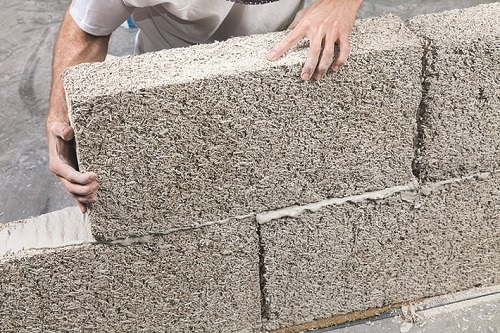 Friday, September 27, 2024
Friday, September 27, 2024  Friday, September 27, 2024
Friday, September 27, 2024 
Ask someone to name a product containing hemp and most likely, he or she will mention consumables or clothing. Yet for centuries, humankind has used the Cannabis sativa plant’s woody stem in construction projects, breaking it into pieces and mixing it with lime and water to create an insulative, non-load-bearing material. Over the years, this nontoxic substance has been called hemp-lime or hemp concrete. Today it’s called hempcrete.
Durable and sustainable, hempcrete has appeared in a range of historical structures over the centuries, perhaps most notably in India’s sixth century temple complex, the Ellora Caves, a UNESCO World Heritage Site. Its use in the 1986 restoration of Maison de la Turque in Nugent-sur-Seine, France, spurred a renewed interest in hempcrete in that country. It has since made its way into contemporary residential renovations and construction in Europe, Australia, and North America. Cast into blocks or panels, hempcrete finds its way into walls, floors, ceilings, and roofs. And though some form of hempcrete has existed for centuries, standards for it have not. Developing these standards is the work of ASTM International’s subcommittee on industrial hemp (D37.07).
The subcommittee, part of the cannabis committee (D37), focuses on nonpsychoactive hemp cultivated for use in producing textiles, paper, food, cosmetics, construction materials, and other manufactured goods. Hempcrete is one of these industrial commodities.
Two of the six new standards proposed by the subcommittee address hempcrete and its fire-resistant properties. The first proposed standard (test methods for evaluating the appropriateness/applicability of current R-value and fire resistance test methods, WK70549) provides a way to evaluate existing insulation test methods to determine if they can be applied to hempcrete. The second (test method for establishing unbiased R-value and fire resistance properties of hempcrete insulation materials, WK70550), will help determine a research and development protocol to generate unbiased R-value and fire-resistance data for hempcrete. According to Darwin Millard, subcommittee chair, and partner and co-founder of Phytologix, the ultimate goal is a set of performance standards that any building inspector can use to approve a hempcrete structure.
Because hempcrete is an insulative, rather than structural, substance, the subcommittee decided to work on performance rather than material specifications, says Millard.
“Performance specifications will allow for hempcrete manufacturers to produce hempcrete in any way they see fit, using any number of aggregates or binders, and make it easier for hemp building projects to get permitted and pass inspection, so long as the hempcrete meets the performance specification. Creating a performance specification for hempcrete insulation removes any bias from the manufacturing process and puts all of the onus on meeting the specification,” Millard says.
By concentrating on performance, the standards should avoid any conflicts regarding manufacturing methods and binder composition, which may differ depending on locale.
The next publication deadline is Friday at noon
Join Construction Links Network